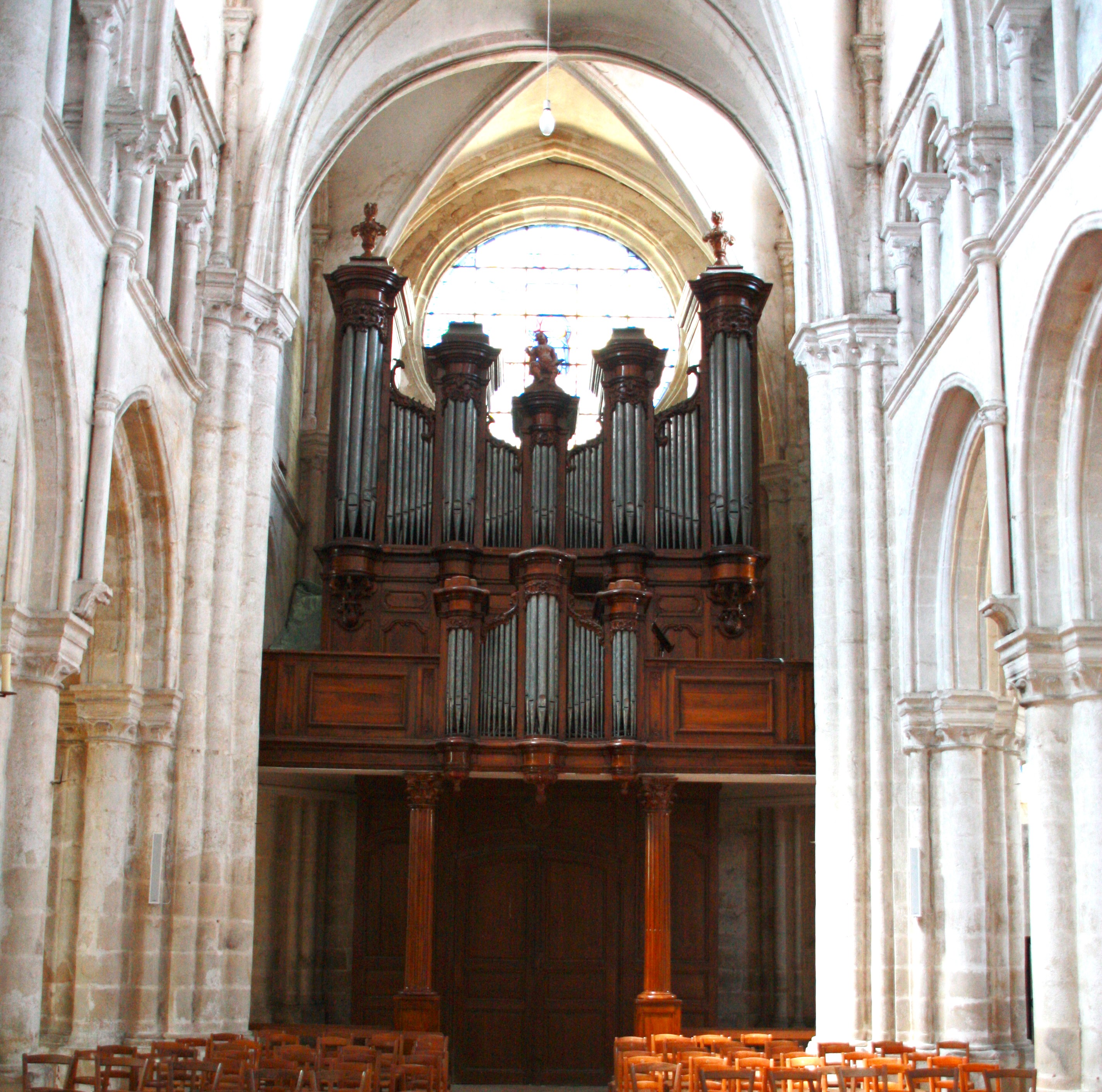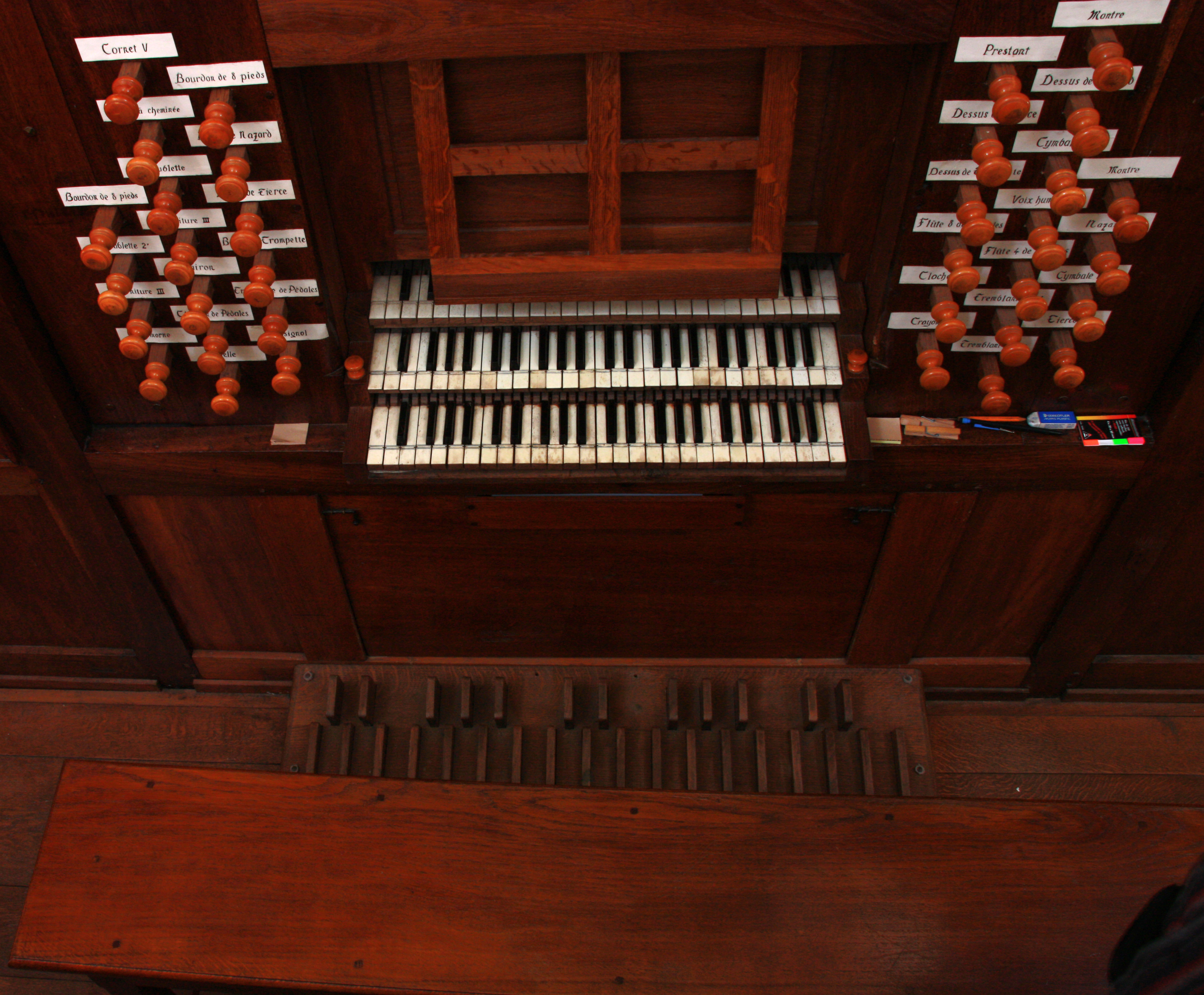Rozay-en-Brie, Église Notre-Dame
| Builder | L. Clicquot |
|---|---|
| Year | ca. 1723 |
| Period/Style | Baroque |
| Stops | 29 |
| Keyboards | 3+P |
| Keyaction | tracker/mechanical |
| Sampleset |
Available
 , sampled by
Sonus Paradisi
, sampled by
Sonus Paradisi
|
The instrument is located in the French village Rozay-en-Brie, in the church Notre-Dame-de-la-Nativité.
Little is known about the origin of the instrument. We know the names of some of the Rozay church organists in 16th and 17th centuries, but they almost certainly played the earlier renaissance instrument there. The church already had an instrument in the 14th century. A small part of its organ case is still preserved.
The traditions says that the present instrument is from the first half of the 18th century, perhaps 1723, with its builder being Louis-Alexandre Clicquot (1684-1760), but there are no documents to prove this assertion. Other sources say that François Deslandes has got the contract to build an new organ and he finished the Positif in 1723. Unfortunately, he died in 1729 and didn't finish the organ. Louis-Alexandre Clicquot did finish the organ in 1737. In any case, parts of the instrument are clearly from 17th century, probably rearranged in 1737 at the latest. The preserved original 17th century stop jamb panel including the stop labels made it possible to restore the 17th century state of the instrument. The layout of its stop labels (providing hints for divided stops) corresponds exactly to the preserved state of the windchest. The core of the Grand Orgue comes from ca. 1680, but numerous parts are of an earlier origin, probably from 16th century.
The special feature of this instrument is the split point, which is between middle c and c# for the split stops (all the Cornets still start at middle c, though). It is also the only French organ of 17th century still having its original keyboards in a playable condition, the keyboards once touched by the members of the Couperin organ dynasty, whose home, Chaumes en Brie, is situated nearby.
At the beginning of 19th century, the organ was in a deplorable state, nearly forgotten and almost falling apart. In 1854 the organ got an new wind system. Nevertheless, about 95% of its original parts and pipes were preserved. The first larger restoration of the instrument took place in 1930-33 by Gabriel d'Alencon. He altered the specification and constructed new keyboards. The original ones were stored. The second restoration by Yves Cabourdin, completed in 1996, restored the original design of the XVIIth century instrument. The original keyboards were placed back and the changes of 1933 were undone.
Little is known about the origin of the instrument. We know the names of some of the Rozay church organists in 16th and 17th centuries, but they almost certainly played the earlier renaissance instrument there. The church already had an instrument in the 14th century. A small part of its organ case is still preserved.
The traditions says that the present instrument is from the first half of the 18th century, perhaps 1723, with its builder being Louis-Alexandre Clicquot (1684-1760), but there are no documents to prove this assertion. Other sources say that François Deslandes has got the contract to build an new organ and he finished the Positif in 1723. Unfortunately, he died in 1729 and didn't finish the organ. Louis-Alexandre Clicquot did finish the organ in 1737. In any case, parts of the instrument are clearly from 17th century, probably rearranged in 1737 at the latest. The preserved original 17th century stop jamb panel including the stop labels made it possible to restore the 17th century state of the instrument. The layout of its stop labels (providing hints for divided stops) corresponds exactly to the preserved state of the windchest. The core of the Grand Orgue comes from ca. 1680, but numerous parts are of an earlier origin, probably from 16th century.
The special feature of this instrument is the split point, which is between middle c and c# for the split stops (all the Cornets still start at middle c, though). It is also the only French organ of 17th century still having its original keyboards in a playable condition, the keyboards once touched by the members of the Couperin organ dynasty, whose home, Chaumes en Brie, is situated nearby.
At the beginning of 19th century, the organ was in a deplorable state, nearly forgotten and almost falling apart. In 1854 the organ got an new wind system. Nevertheless, about 95% of its original parts and pipes were preserved. The first larger restoration of the instrument took place in 1930-33 by Gabriel d'Alencon. He altered the specification and constructed new keyboards. The original ones were stored. The second restoration by Yves Cabourdin, completed in 1996, restored the original design of the XVIIth century instrument. The original keyboards were placed back and the changes of 1933 were undone.
| Positif | Grand Orgue | Récit | Pedal |
|---|---|---|---|
| Bourdon 8′ | Montre 8′ | Cornet V | Flute 8′ |
| Montre 4′ | Bourdon 8′ | Flute 4′ | |
| Doublette 2′ | Prestant 4′ | Trompette 8′ | |
| Nazard 2 2/3′ | Flute 4′ | Clairon 4′ | |
| Tierce 1 3/5′ | Doublette 2′ | ||
| Fourniture III | Nazard (bass) 2 2/3′ | ||
| Cymbale II | Nazard (desc.) 2 2/3′ | ||
| Cromorne 8′ | Tierce (bass) 1 3/5′ | ||
| Tierce (desc.) 1 3/5′ | |||
| Fourniture III | |||
| Cymbale III | |||
| Cornet V | |||
| Trompette (bass) 8 | |||
| Trompette (desc.) 8′ | |||
| Clairon 4′ | |||
| Voix humaine 8′ |
1463755242-Corrette-PleinJeu-Rozay
0:00
0:00
1464148196-Titelouze - Ad Caenam Agni Providi
0:00
0:00
1463755176-Couperin-Cromhorne-Rozay
0:00
0:00
1463755310-Corrette-Duo-Rozay
0:00
0:00
https://www.sonusparadisi.cz/en/organs/france/rozay-virtual-organ-model.html
 Pipe Organ Map
Pipe Organ Map


